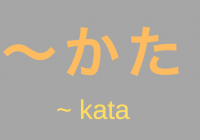まえ (mae) vs まで (made): what’s the difference?
Words that sound similar can cause trouble for those learning a foreign language, especially if the words have similar meanings. In this post I want to go over the difference between the Japanese words ”mae” (written either as まえ or 前) and “made” (usually written as まで, but in rare cases as 迄), which are… Read More »


